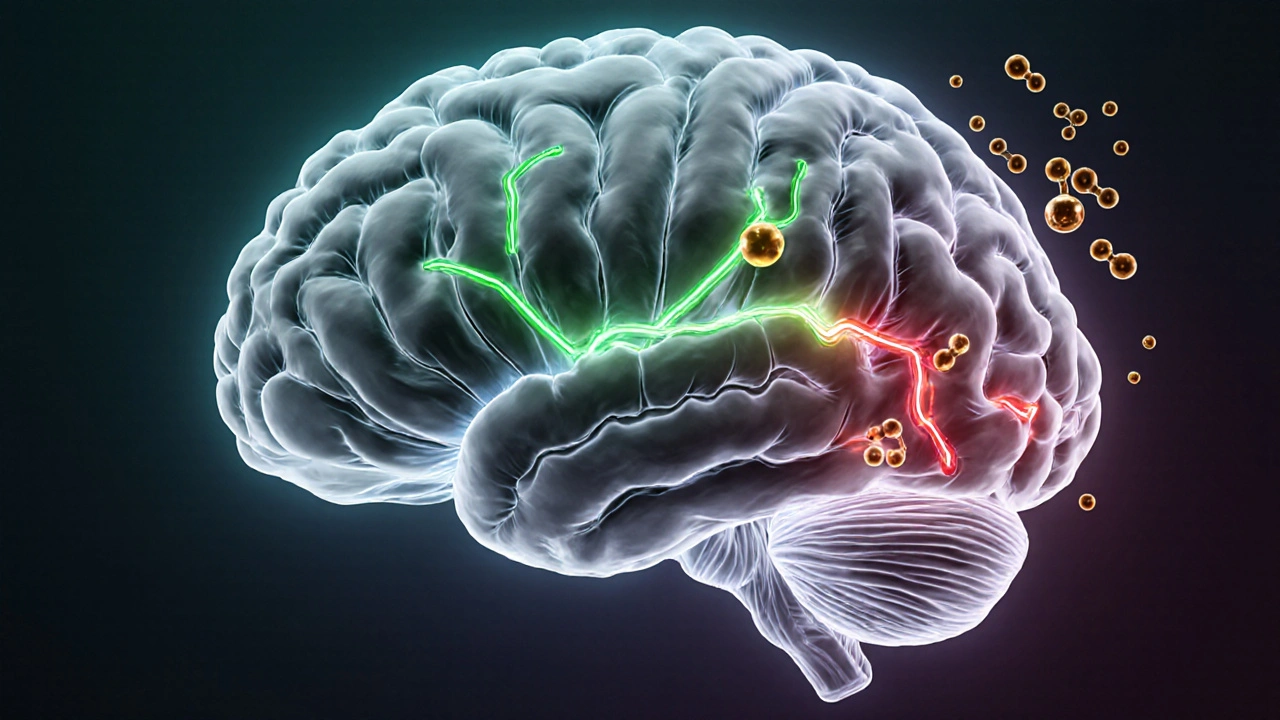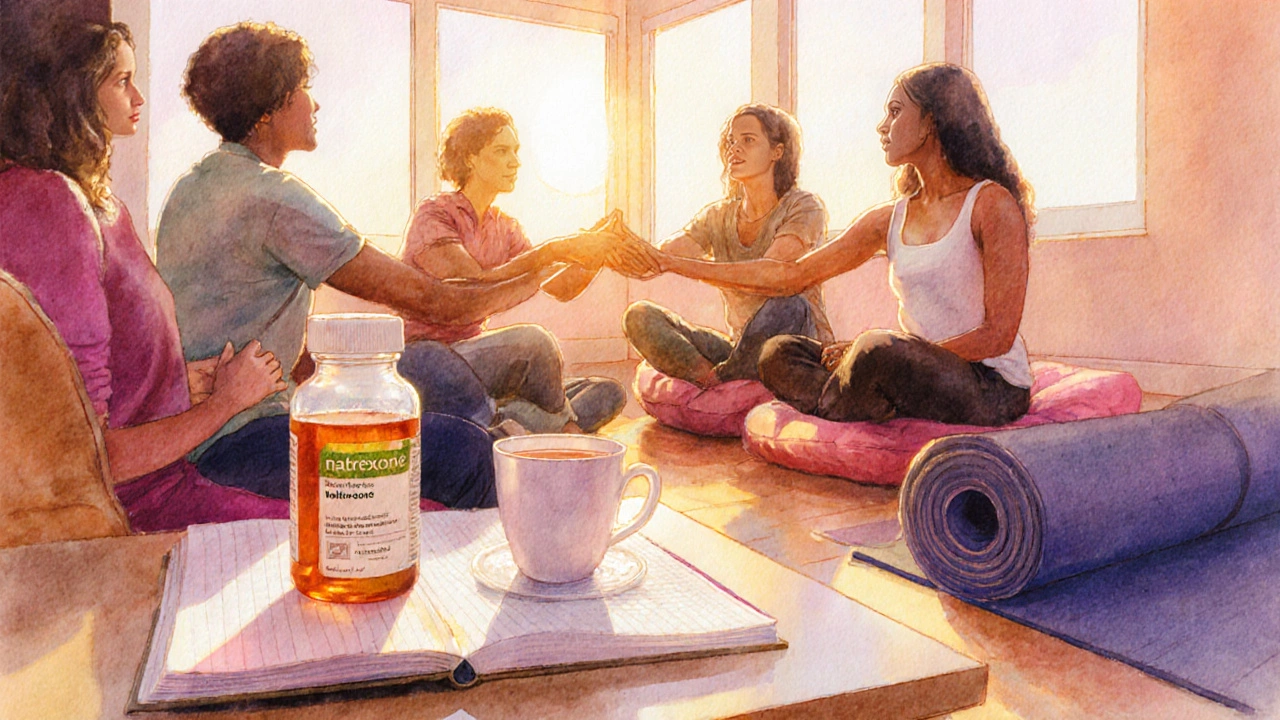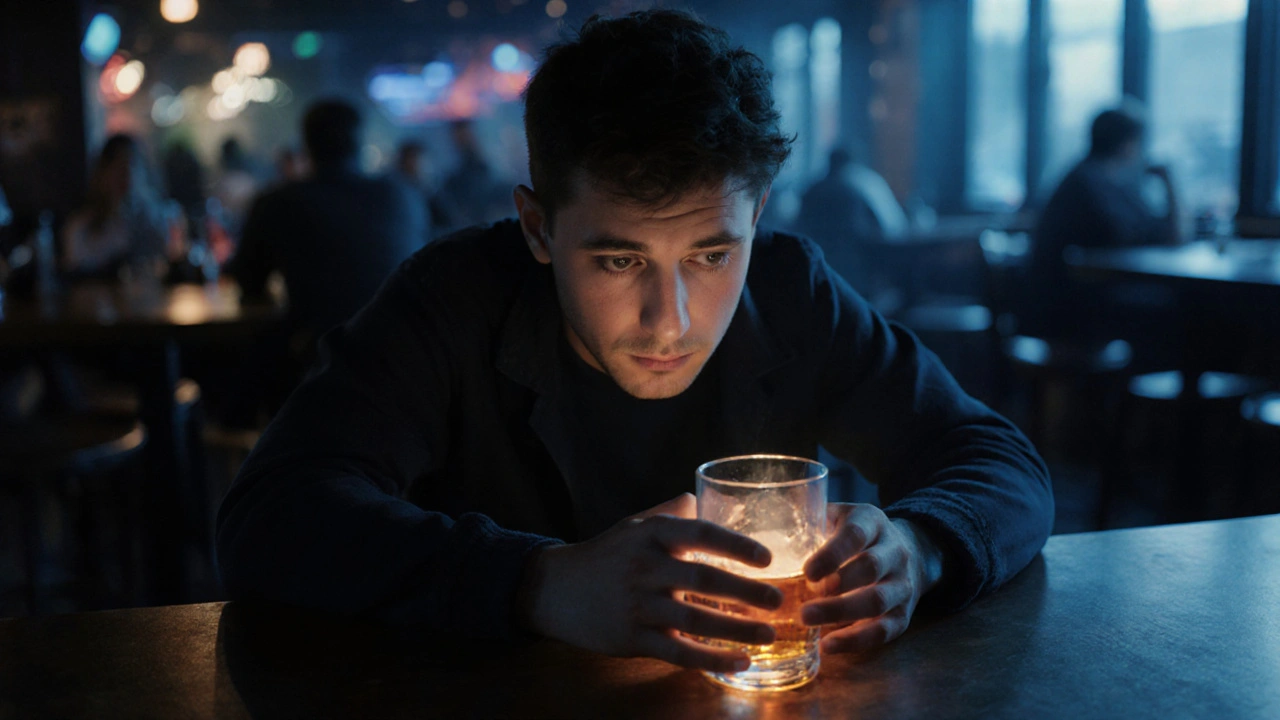Ever wonder why binge drinking evenings often end with a heavy heart or racing thoughts? That’s not a coincidence. Alcohol changes the brain chemistry, and over time it can spark or worsen mental health problems. Understanding that two‑way street helps you spot warning signs early and choose the right help.
Key Takeaways
- Alcohol use directly alters neurotransmitters, increasing risk of depression and anxiety.
- Co‑occurring disorders are common; about 1 in 3 people with a mental illness also struggle with alcohol dependence.
- Screening tools like AUDIT and PHQ‑9 can catch issues before they spiral.
- Integrated treatment-combining medication‑assisted therapy, counseling, and peer support-offers the best chance of lasting recovery.
- Self‑care habits such as regular sleep, exercise, and mindfulness reduce relapse risk.
How Alcoholism Affects the Brain and Mood
Alcoholism is a chronic disease marked by loss of control over drinking, tolerance, and withdrawal symptoms. It interferes with the brain’s reward system, altering dopamine and serotonin levels, which are crucial for mood regulation. The constant flood of alcohol forces the brain to adapt, leading to reduced natural production of these chemicals. When drinking stops, the brain struggles to rebalance, often leaving the person feeling down, irritable, or anxious.
Research from the National Institute on Alcohol Abuse and Alcoholism shows that long‑term heavy drinking lowers the volume of the prefrontal cortex- the area responsible for decision‑making and impulse control. That shrinkage explains why many people find it harder to resist cravings or think clearly after years of heavy use.
Common Mental Health Conditions Linked to Alcohol Use
Depression is a mood disorder characterized by persistent sadness, loss of interest, and fatigue. When alcohol depresses the central nervous system, it can trigger or exacerbate depressive episodes. A 2023 Australian study found that 45% of patients diagnosed with major depressive disorder also met criteria for alcohol dependence.
Anxiety includes generalized anxiety, panic attacks, and social anxiety, all marked by excessive worry and physical tension. Alcohol initially seems to calm nerves, but as tolerance builds, the brain experiences heightened anxiety during withdrawal periods. This cycle often pushes people back to the bottle for temporary relief, deepening the problem.
Other co‑occurring disorders include bipolar disorder, post‑traumatic stress disorder (PTSD), and schizophrenia. Each shares a bidirectional relationship with alcohol: symptoms can lead to self‑medication, while alcohol can worsen psychiatric symptoms.
Spotting the Signs of a Co‑Occurring Disorder
Because the symptoms overlap, it’s easy to miss the whole picture. Look for these red flags:
- Increasingly drinking to “feel normal” after stressful events.
- Feeling empty or hopeless when not drinking.
- Sudden changes in sleep patterns-either insomnia or heavy sleeping.
- Withdrawal from friends, hobbies, or work responsibilities.
- Physical signs: tremors, frequent headaches, or unexplained weight loss.
If you tick several of these boxes, consider a professional screening.

Screening Tools You Can Use Right Now
Two quick questionnaires are trusted worldwide:
- AUDIT (Alcohol Use Disorders Identification Test): ten questions that gauge consumption, dependence symptoms, and harmful use.
- PHQ‑9 (Patient Health Questionnaire): measures depression severity and can hint at underlying anxiety.
Both can be completed in under ten minutes online or in a clinic. Scores above the recommended thresholds suggest a need for a deeper assessment.
Integrated Treatment: What Works Best
Treating alcoholism in isolation often fails because the mental health component fuels relapse. Integrated programs address both simultaneously. Below is a snapshot of the most common approaches.
| Option | Primary Goal | Key Components | Typical Duration |
|---|---|---|---|
| Medication‑Assisted Treatment (MAT) | Reduce cravings & prevent withdrawal | Disulfiram, Naltrexone, Acamprosate | 3‑12 months, often longer |
| Psychotherapy (CBT, DBT) | Change thought patterns & coping skills | Individual & group sessions, skill‑building | 12‑24 weeks, ongoing boosters |
| Support Groups (AA, SMART Recovery) | Provide peer accountability & community | Weekly meetings, 12‑step or evidence‑based | Indefinite, lifelong participation |
| Integrated Dual‑Diagnosis Programs | Address both substance use & mental illness together | Combines MAT, psychotherapy, psychiatry, case management | 6‑18 months, tailored to individual needs |
Studies in 2024 show that patients in dual‑diagnosis programs have a 35% higher chance of staying sober after one year compared with those receiving only standard addiction counseling.
Daily Strategies to Support Recovery
Even with professional help, everyday habits make a huge difference. Try these proven tactics:
- Sleep hygiene: Aim for 7‑9 hours, keep a consistent bedtime, and limit caffeine after 2pm.
- Physical activity: Moderate exercise boosts endorphins, helping to counteract low serotonin levels caused by alcohol.
- Mindfulness or meditation: Short daily sessions reduce stress hormones and improve emotional regulation.
- Nutrition: Replenish B‑vitamins, magnesium, and omega‑3s that alcohol depletes.
- Social connections: Stay linked to sober friends or family members; isolation drives relapse.
Tracking progress with a simple journal-note cravings, mood, and triggers-helps you see patterns and adjust your plan quickly.

Preventing Relapse: Early Warning Signs & Action Plan
Relapse isn’t a failure; it’s a signal that something needs tweaking. Common early cues include:
- Increased irritability or “doom‑scrolling” on social media.
- Skipping therapy appointments or support meetings.
- Justifying a single drink as “harmless”.
- Feeling overwhelmed by work or relationships.
When you notice any of these, act fast:
- Call your sponsor or therapist within 24hours.
- Remove alcohol from your environment for at least 48hours.
- Engage in a distraction activity-exercise, a hobby, or a walk.
- Re‑evaluate your coping strategies and update your journal.
Resources and Where to Get Help
In Melbourne and across Australia, a range of services are ready to assist:
- Alcohol and Drug Information Service (ADIS): 24/7 phone line, free counseling, and referral to local programs.
- Beyond Blue: Specialized support for depression and anxiety linked to substance use.
- Heads Up: Offers free mental health assessments and guides to treatment options.
- Local hospitals: Many have integrated dual‑diagnosis units-ask for a mental health liaison.
Remember, you don’t have to navigate this alone. Professional help combined with personal effort creates a solid foundation for lasting wellness.
Putting It All Together
Understanding the tight bond between alcoholism and mental health equips you to break the cycle. Spot the signs, get screened, choose integrated treatment, and build daily habits that protect your mind and body. With the right support, recovery is not just possible-it’s sustainable.
Frequently Asked Questions
Can occasional binge drinking cause mental health issues?
Yes. Even sporadic heavy drinking floods the brain with dopamine, then crashes the system, often leading to anxiety or depressive symptoms within days.
Is it safe to use medication‑assisted treatment if I have depression?
Generally, yes. Medications like Naltrexone don’t interact with most antidepressants, but a psychiatrist should monitor any changes in mood or side effects.
How long does it take to see mental health improvement after quitting alcohol?
Physical detox can clear most alcohol from the system in a week, but emotional stability often starts to lift after 2‑4 weeks of sustained sobriety, with continued gains over months.
Do support groups help people with co‑occurring anxiety?
Support groups provide peer accountability and shared coping tools, which can lower anxiety levels. Pairing them with CBT yields the strongest outcomes.
What should I do if I relapse after months of sobriety?
Treat it as a learning moment. Contact your therapist or sponsor immediately, identify the trigger, and adjust your relapse prevention plan. Many people re‑enter treatment and stay sober long‑term.


Rita Joseph
October 5, 2025 AT 17:28Thanks for sharing such a thorough overview of the alcohol‑mental health connection. It really helps to break down how neurotransmitters get thrown off balance and why cravings can feel so powerful. I’ve seen people underestimate how quickly anxiety can creep back in during withdrawal, so emphasizing early screening is key. The practical tips on sleep, exercise, and mindfulness are spot on for building a stable routine. Keep the inclusive tone – it makes the information feel accessible to anyone looking for help.
abhi sharma
October 5, 2025 AT 17:45Yeah, because binge drinking totally solves everything, right?
mas aly
October 5, 2025 AT 18:02The article does a solid job of linking the brain chemistry changes to everyday feelings. It’s useful to remember that the prefrontal cortex shrinkage isn’t just a medical fact – it shows up as real‑world struggles with impulse control. Integrating counseling with medication can give people a steadier path forward. A balanced routine of sleep, movement, and mindful breathing can really offset some of those chemical lows. Overall, the guidance feels both realistic and encouraging.
Abhishek Vora
October 5, 2025 AT 20:48When we examine the neurobiological cascade triggered by chronic ethanol exposure, the narrative becomes dramatically clear. Alcohol acts as a potent agonist at GABA receptors while simultaneously dampening NMDA‑mediated glutamatergic transmission, leading to a profound inhibitory state. Over time, homeostatic mechanisms up‑regulate excitatory pathways, which explains the severe anxiety during withdrawal phases. Moreover, the reduction in dopaminergic firing in the mesolimbic circuit fuels the relentless pursuit of the next drink to recapture fleeting euphoria. The consequent atrophy of the prefrontal cortex erodes executive function, making rational decision‑making almost impossible. This cascade isn’t merely theoretical; it manifests as the palpable dread and irritability described by countless patients. Therefore, the call for integrated dual‑diagnosis programs isn’t just a recommendation – it’s a neuro‑imperative. By simultaneously targeting serotonergic deficits with SSRIs and curbing cravings with Naltrexone, we restore a semblance of neurochemical equilibrium. The dramatic interplay of these treatments underscores why monotherapy often fails. In conclusion, a holistic, neuro‑informed approach is essential for lasting recovery.
maurice screti
October 6, 2025 AT 13:28One cannot help but marvel at the sheer intricacy of the relationship between alcohol consumption and psychiatric well‑being, a relationship that, in my humble estimation, is often relegated to the periphery of mainstream discourse. The piece deftly navigates the labyrinthine pathways of dopamine and serotonin dysregulation, elucidating how prolonged exposure to ethanol precipitates a cascade of neurochemical perturbations that many laypersons would scarcely conceive. Moreover, the statistical exposition-particularly the revelation that a staggering one in three individuals with a mental health diagnosis concurrently grapples with alcohol dependence-serves as a clarion call for clinicians to adopt a more integrative diagnostic lens. It is, however, the exposition on treatment modalities that truly captivates the intellect; the juxtaposition of Medication‑Assisted Treatment (MAT) against psychotherapeutic interventions such as CBT and DBT not only underscores the necessity of a multimodal framework but also invites a nuanced deliberation on individualized patient pathways. The tabular comparison of treatment options, replete with granular details regarding primary goals, key components, and typical durations, reads like a veritable atlas for the discerning practitioner. Further, the emphasis on quotidian habits-sleep hygiene, physical activity, mindfulness-serves as a testament to the oft‑underappreciated power of lifestyle engineering in fortifying the neurobiological gains wrought by formal therapy. While the article excels in breadth, one might proffer that a deeper excavation into the genetic predispositions that mediate susceptibility to co‑occurring disorders would enrich the discourse. Nevertheless, the inclusion of region‑specific resources, notably the Australian and Melbourne services, enhances the pragmatic utility of the composition for a global audience. In summation, the synthesis presented herein not only demystifies a complex clinical phenomenon but also furnishes a comprehensive roadmap for both clinicians and patients endeavoring toward sustained sobriety and mental equilibrium.
Abigail Adams
October 6, 2025 AT 13:45The exposition, while thorough, unfortunately skirts the perilous reality that many self‑help narratives romanticize recovery. It is imperative to recognize that medication adherence is fraught with compliance challenges, which the article glosses over. Additionally, the reliance on peer support groups can be a double‑edged sword for individuals harboring deep‑seated mistrust. The tone, albeit formal, would benefit from a more critical appraisal of the socioeconomic barriers that impede access to dual‑diagnosis programs. Ultimately, without addressing these systemic shortcomings, the guidance remains somewhat idealistic.
Belle Koschier
October 6, 2025 AT 14:02I appreciate the balanced presentation of both medical and lifestyle interventions. Highlighting community resources alongside professional treatment underscores the importance of a supportive network. The suggestion to keep a journal for tracking cravings and mood is a practical tool that many can adopt. Overall, the tone encourages collaboration rather than isolation, which is essential for sustainable recovery.
Allison Song
October 6, 2025 AT 14:18From a philosophical standpoint, the interplay of habit and neurochemistry reflects the broader dialectic between free will and determinism. Recognizing patterns in one's behavior can empower a more intentional existence. The article subtly invites readers to become the architects of their own mental architecture.
Joseph Bowman
October 6, 2025 AT 14:35It’s fascinating how the mainstream narrative often omits the shadowy influence of industry lobbying on public health guidelines. While the article offers solid advice, one must stay vigilant about the subtle ways commercial interests shape what’s considered ‘best practice.’ Nevertheless, the emphasis on personal vigilance and community support remains a cornerstone for true autonomy in recovery.
Singh Bhinder
October 6, 2025 AT 14:52The practical steps outlined, especially the call to use screening tools like AUDIT and PHQ‑9, provide a clear entry point for self‑assessment. Pairing these tools with consistent exercise and mindfulness creates a comprehensive approach. Awareness of early warning signs can prevent the spiral before it accelerates. This balanced perspective aligns well with evidence‑based practices.
Kelly Diglio
October 6, 2025 AT 15:08The article presents a well‑structured overview that is both informative and compassionate. Emphasizing integrated treatment acknowledges the complexity of co‑occurring disorders, which is crucial for effective care. Providing concrete resources while also encouraging daily self‑care habits empowers readers to take actionable steps. The tone strikes an appropriate balance between clinical precision and empathetic support.